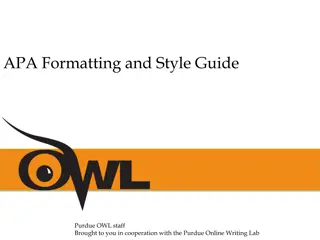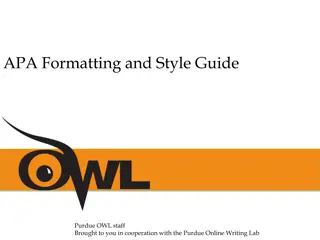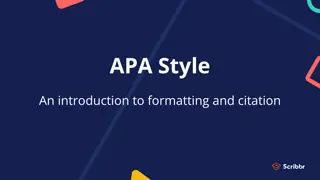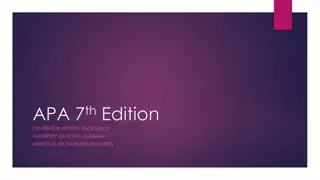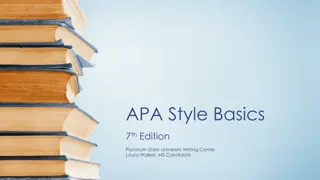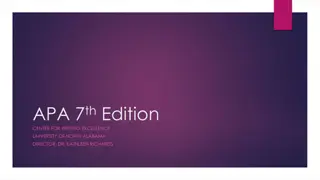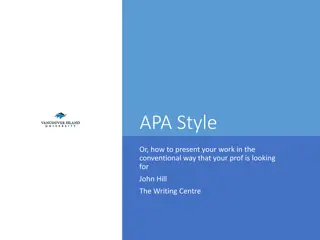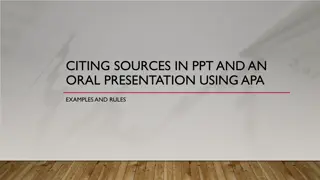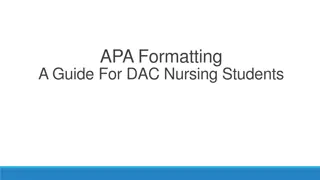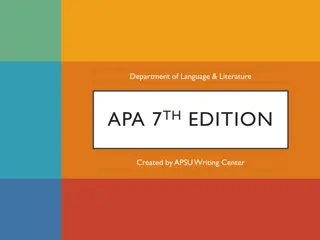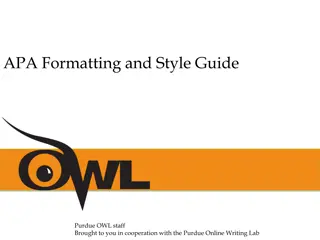Updated Guidelines for APA In-Text Citations: 7th Edition Changes
Guidelines for in-text citations in the 7th edition of the APA manual including handling direct quotes with proper formatting, citing paraphrases accurately, and addressing the use of page and paragraph numbers when available or not. It also covers the variation in citation based on the number of authors and the use of signal phrases versus parenthetical citations.
Download Presentation

Please find below an Image/Link to download the presentation.
The content on the website is provided AS IS for your information and personal use only. It may not be sold, licensed, or shared on other websites without obtaining consent from the author. Download presentation by click this link. If you encounter any issues during the download, it is possible that the publisher has removed the file from their server.
E N D
Presentation Transcript
APA: IN-TEXT CITATIONS Updated for the 7th Edition of the APA Manual
DIRECT QUOTES If you take an author s ideas and their words The author s words are included verbatim in your work Be sure to place quotation marks around the quoted material At this point, you must cite the source as a direct quote which includes: Last name, publication date, and page or paragraph number , or section/heading, plus quotation marks If you re citing verbatim, Quoted material goes here (Hall, 2016, p. 22) . Use a page number citation for books and peer-reviewed journals that have clear and designated page numbers
PARAPHRASE When you summarize an author s idea in YOUR own words A paraphrase cannot simply replace one or two of the author s words with your own; it must be entirely your own wording No page or paragraph number is necessary Only need author last name, date (Hall, 2016)
FORMATTING Number of authors The number of authors you have alters the in-text and reference citation See the inside cover of your APA manual or page 266 table 8.1 Signal phrase a.k.a narrative citation When the author is part of the sentence (often acts as the subject) Walker (2014) found, . . .. . (p. 25). Parenthetical When the citation comes at the end of the sentence COVID-19 was first detected in the U.S. in February 2020(Allen, 2015).
Direct Quotations Continued Page, Paragraph, Section, or Heading First choice: Use a page number if given Use anyof the following approaches if no page number is provided: Paragraph number (manually count if not numbered) Section name or heading abbreviate if the full heading/section is too long Section name/Heading AND a paragraph number Examples provided on the next slide OR see page 273 section 8.28 in your 7th edition
PAGE AND PARAGRAPH NUMBERS Use page number when they are designated (i.e. not computer or printer generated) Parenthetical: (Hall, 2015, p. 4). Signal phrase/Narrative: Hall (2015) claimed, . . . (p. 4). Do ANY of the following if no page number is given. **ALL options are equally acceptable: Heading or section name (Brown, 2018, Participant section). *no paragraph number Abbreviated heading or section name in quotation marks (Williams, 2017, What Comes Next section).*also no paragraph number Paragraph number (Smith, 2020, para. 26). Heading or section with a paragraph number (Johnson, 2016, Results section, para. 10). **Note: The period ENDS the sentence after the parenthesis; this way the reader knows where the citation applies. See page 273 section 8.28
PUBLICATION DATE In APA, you can drop the publication date from signal phrases (i.e. narrative citations) within the same paragraph for the same source as long as it s a paraphrase NOT a direct quote. Direct quotes always require a date. As long as the source being cited is clear, no need to repeat the date for every citation in the same paragraph First citation in paragraph example: Hall and Johnson (2007) found . . . All other citations in that same paragraph example: Hall and Johnson also stated... Note:when you start a new paragraph, if you reuse this source you MUST give the date again the first time you cite it. First time in new paragraph= Name, date. Hall and Johnson (2007) defined . . . Subsequent citations in same paragraph= name only: Hall and Johnson further differentiated between . . . All parenthetical citations remain the same(always author AND date) Page 265 section 8.16: Omitting the year in repeated narrative citations
BLOCK/LONG QUOTES Any directly quoted material of 40 words or more. Can introduce with author name and date followed by a colon. Indent ALL quoted material inch ( 0.5 on the ruler bar) Omit quotation marks After block quote, always explain Begin first line after quote without an indentation. If you indent that line you are starting a new paragraph. Page 272 section 8.72: Block quotations
BLOCK/LONG QUOTE EXAMPLE Jones (1998) interpreted the data as follows: Students often had difficulty using APA style ,especially when it was their first time citing sources.This difficulty could be attributed to the fact that manystudents neglected to purchase a style manual or ask their teacher for help. (p. 199) Note: the period comes BEFORE the page number in block quotes. This is the only time it does so.
INDIRECT SOURCES/SECONDARY SOURCES Someone else s version/interpretation of an original work Use these sparingly, as they are inherently biased When to use: When an original is out of print, impossible to find/acquire, or in a language you don t understand. IF POSSIBLE: Find the primary source (original), read it, and cite it directly HOW DO I CITE IT? In your writing, give the original (primary source) then use as cited in to cite the secondary source where you found it (exclude the original sources year if you don t have it) Allport s diary (original date) . . . (as cited in Nicholson, 2003). **Allport is the original (primary source) but you did not read his original diary. Instead, you read Nicholson s presentation or interpretation of his diary (a secondary source), so Nicholson would be cited in the reference list and in the parenthetical as shown.
INDIVIDUAL EXAMPLES Check out the following for more specific examples.
SINGLE AUTHOR Author last name, date Ex. (Hall, 2017) This citation remains consistent throughout your work
TWO AUTHORS One work by two authors Author last names, date Signal phrase/Narrative Citation Hall and Johnson (2016) Parenthetical: (Hall & Johnson, 2016) Consistent throughout
3 OR MORE AUTHORS One work by 3 or more authors Cite only the last name of the first author plus et al. every time Example: Authors= Johnson, Smith, Brown, and Williams Signal phrase/narrative citation: Johnson et al. (2016) . . . Parenthetical: (Johnson et al., 2016).
CORPORATE AUTHORS (Gray Literature) When the publisher and the author are one in the same. Most common for government organizations or large organizations. i.e. Mayo Clinic, Department of Health and Human Services, etc. The publisher would then be cited as follows: Signal/Narrative: Mayo Clinic (2016) found. . . Parenthetical: (Mayo Clinic, 2016).
AUTHOR ABBREVIATIONS Can be abbreviated if the abbreviation is easily recognizable and you have given the full term and abbreviation the first time it enters your writing Signal/Narrative: According to the Centers for Disease Control (CDC) (2020) Parenthetical: (Centers for Disease Control [CDC], 2020). Now CDC will be used throughout the paper, in place of Centers for Disease Control. DO NOT define terms abbreviated in the dictionary (i.e. AIDS= AIDS no need to write it out the first time) Page 173 section 6.25 in the 7th edition
Still Have Questions? If you don t own a 7th edition, then go hereor here Link 1: APA Style Blog Link 2:Purdue OWL Formatting and Style Guide 1. Both are updated to the 7th edition of APA. a. The Style Blog has a handy search function to pinpoint answers to your questions b. The OWL uses links to the left of the page to organize their work--just scroll and click on what you need.
Helpful Page Numbers in the 7th Edition Page 259: Personal Communications (i.e interview), page 260 has an example Page 262: Figure 8.2 as well as section 8.11 on the same page Page 264 section 8.13: Citing specific sections of a source Page 266 Table 8.1: Basic in-text citation styles Pay close attention to this one it changed from the 6th to 7th edition Page 272 Table 8.2: Examples of direct quotations cited in the text This is a useful table that provides examples and explanations of appropriately cited direct quotes Page 275 section 8.31: Changing direct quotes you would use these options to add clarity to your writing--figure 8.6 is an excellent example/explanation
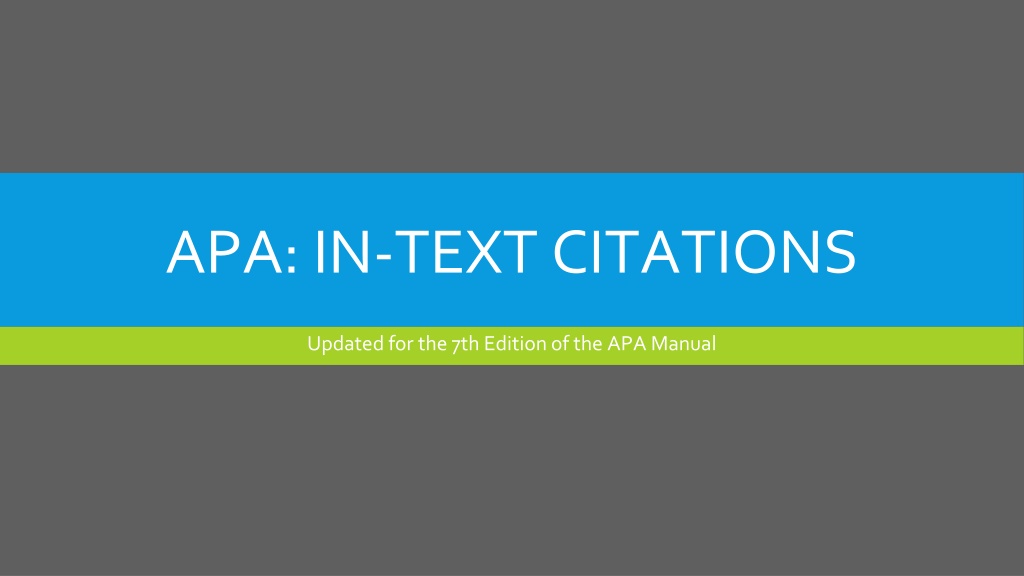
 undefined
undefined





